May 24, 2010 – 08:40 am ET
The bears asserted their authority over the last week and the market closed down at levels south of those seen before the big European bailout. Apparently a trillion dollars will buy you a good time but not a long time these days. All of the targets set last week have already been reached or exceeded… so please spread the word about this newsletter if you enjoy receiving it (thanks).
I came across an article by Irish journalist Brendan O’Connor’s who made some brilliant observations in the Sunday Independent about the backwards nature of the bailouts and how they are rewarding those who have been the most irresponsible:
“…there is plenty of money in the world, and yet everybody is up to their neck in debt… maybe it’s time to start again.
Maybe it’s time for not just us to default, but for everyone to default. They (whoever ‘they’ are) will get over it soon enough and they’ll give us more money to buy stuff from them.
It would be a delinquent thing to do, yes. But if we’ve learn’t anything from all this, and we haven’t really, it’s that being good gets you nowhere.”
.
ETF % Change Comparison
.
 .
.
For the week ending 16th May; IWM was the top performer and SMH lagged behind but over the last week those roles have reversed. However the total decline from their peaks is similar across the board apart from DIA that has not been hit quite as hard.
.
What the % Comparison Table Tells Us:
By comparing the performance of the economically sensitive (SMH, QQQQ, IWM, IYT) and the comparatively stable ETFs (SPY and DIA) we can get an indication of the true market direction. The more sensitive areas of the market tend to be the first to initiate a trend change. For example if DIA and SPY sell off heavily while SMH and IWM (Russell 2000 small cap ETF) sell of mildly or continue moving to new highs then this would be very positive and vice versa.
The ‘Average Rank %’ is calculated by subtracting the % change for each ETF from the maximum % change and dividing it by the range for each period. 1-((MAX(% change all ETFs)-ETFs % Change)/(MAX(% change all ETFs)-MIN(% change all ETFs))) The readings for each period are then averaged. This reading is provided because if one ETF was significantly under/out performing the others then a plain high or low rank would not accurately reflect this.
.
![]()
.
A Look at the Charts
.
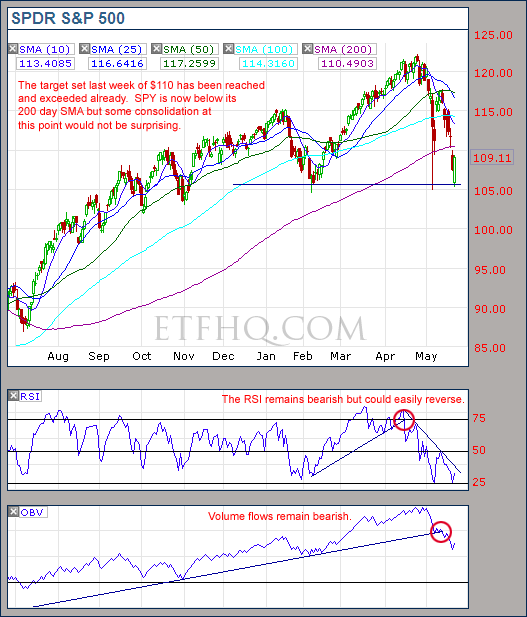
SPY has found support after some sharp declines; this is just the kind of place that consolidation could occur but the bears are still in control.
.

If there is going to be a catalyst for QQQQ it will come from SMH and IWM because they have found much more substantial support.
.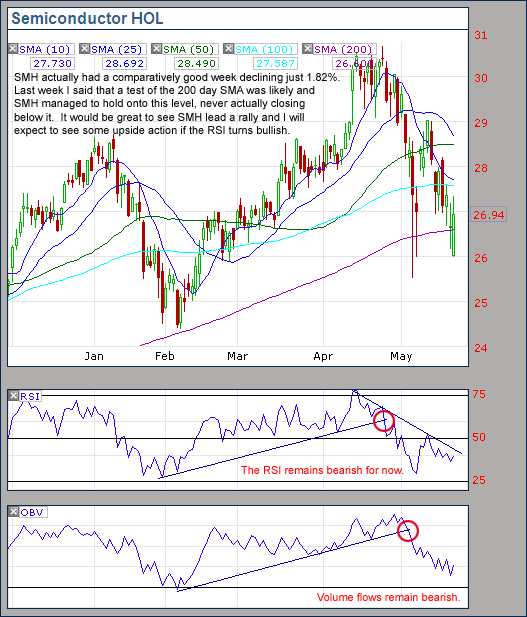
I like the fact that SMH has done a better job of holding onto it’s 200 day SMA than QQQQ and SPY. Keep an eye on that RSI for a good exit signal on short term bearish trades.
.
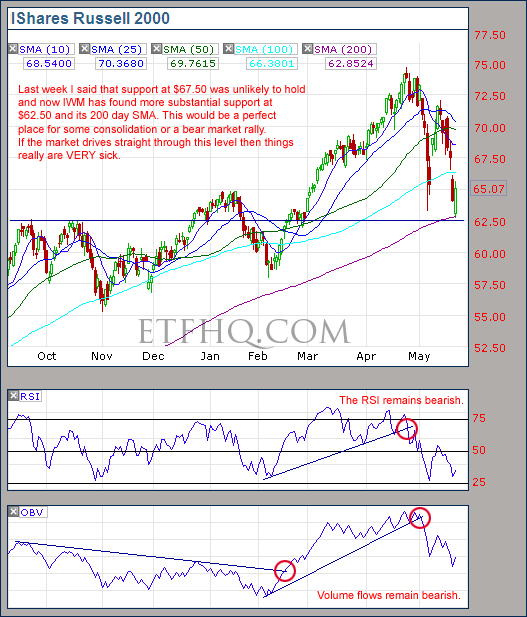
If IWM carries on straight through $62.50 then the markets problems have just begun, this appears unlikely however.
.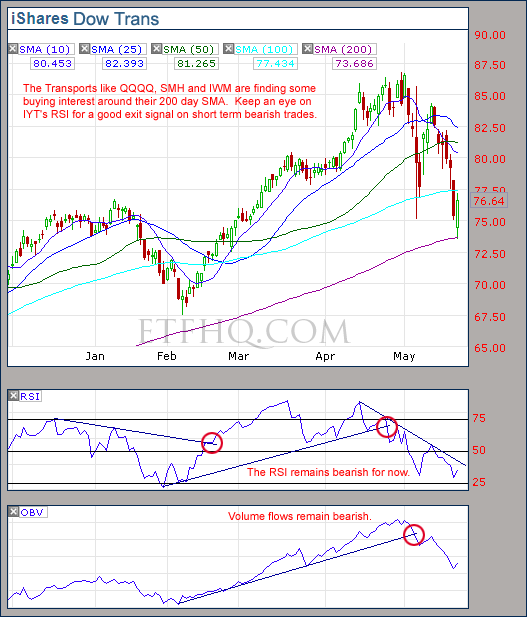
If the transports RSI turns bullish along with SMH’s then new lows would be highly unlikely over the next week.
.
![]()
.
OM3 Weekly Indicator
.

A deteriorating outlook from the OM3 Indicator.
.
How to read the OM3 indicator
The OM3 indicator as with most of our models primarily reads price action and volume. The strong/weak buy/sell signals are self-explanatory. ‘No Signal’ means that the component readings are in conflict and cancel each other out.
The alerts let you know if the cycle is speeding up or slowing down, so when you get at ‘Strong Buy, Bear Alert’ for instance it simply means that the criteria for a strong buy is in place but this weeks cycle reading is weaker (or more bearish) than last weeks reading (the same is true in reverse).
The number of weeks that a signal has been repeated is displayed. Historically a ‘Strong Buy’ signal has lasted for an average of 6 weeks and a maximum of 42 weeks, while a ‘Strong Sell’ has lasted for an average of 4 weeks and a maximum of 16.
This is an indicator not a mechanical trading model. It is useful to assist in analyzing the market but for the best results should be combined with commonsense and support/resistance levels etc.
.
![]()
.
TransDow & NasDow
.
Most of the profits from the DJT trade have gone now but DJT remains dominant over the Dow. Surprisingly the NASDAQ has just regained dominance over the Dow which is positive and indicates that the risk level in the market has lowered.
.
What the TransDow Readings tell us:
The TransDow measures dominance between the DJ Transportation Index (DJTI) and the Dow Jones Industrial Average (DJIA). In a strong market the more economically sensitive Transportation Index should be dominant over the DJIA.
Historically the DJTI has been dominant over the Dow 45% of the time. The annualized rate of return from the DJTI during this period was 18.47% with the biggest loss for one trade sitting at -13.27%. The annualized return from the DJIA during the periods it was dominant over the DJTI was just 4.06% and the biggest loss for one trade was -16.13%. A 4% stop-loss is applied to all trades adjusting positions only at the end of the week.
What the NasDow Readings tell us:
The NasDow measures dominance between the NASDAQ and the DJIA. Using the same theory behind the Trans Dow; in a strong market the more economically sensitive NASDAQ should be dominant over the DJIA.
Historically the NASDAQ has been dominant over the DJIA 44% of the time. Taking only the trades when the NASDAQ is above its 40 week moving average the annualized rate of return was 25.47% with the biggest loss for one trade sitting at –8.59%. The annualized rate on the DJIA during the periods it was dominant over the NASDAQ is just 8.88% and the biggest loss for one trade was –12.28%. A 8% stop-loss is applied to all trades adjusting positions only at the end of the week.
.
![]()
.
LTMF 80 & Liquid Q
.
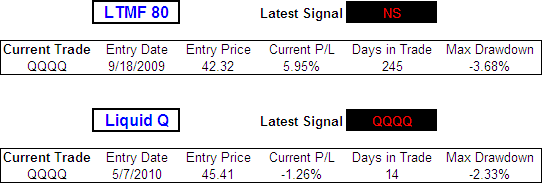
LTMF 80 has finally moved to cash after giving back most of the profits from a trade that lasted 245 days. Liquid Q on the other hand still has an open position in QQQQ but is very close to closing out.
.
Historical Stats:
.

.
How The LTMF 80 Works
LTMF stands for Long Term Market Forecaster. It reads volume flows relative to price action and looks for out performance of volume measured on a percentage basis over the prior 12 months. During a sustained rally the readings will reach high levels (near 100%) making it imposable for the volume reading to always outperform price so any reading above 80% will maintain the buy signal. This system has outperformed the market over the last 10 years but performance has been damaged by some nasty losses. It only produces buy signals and only for QQQQ.
How Liquid Q Works
Liquid Q completely ignores price action and instead measures the relative flow of money between a selection of economically sensitive and comparatively stable ares of the market. It looks for times when the smart money is confident and and can be seen by through volume investing heavily is more risky areas due to an expectation of expansion. This system has outperformed the market over the last 10 years and remained in cash through most of the major declines. It only produces buy signals and only for QQQQ. We will provide more performance details on the web site for these systems soon.
.
![]()
.
Summary
.
Much of the market is down 10% or more over the last 28 days and now some major support levels have been found. There are a few good reasons to believe that these levels will hold over the short term such as:
- SMH only declining 1.82% over the last week.
- Strong buying interest on Friday at support levels.
- Partially oversold conditions.
- The NASDAQ regaining dominance over the Dow.
If the market declines continue through support levels before any consolidation can occur then the market is more unhealthy than even the most bearish have predicted. A more probable outcome is to see some buying interest over the short term before another downward leg.
.
Any disputes, questions, queries, comments or theories are most welcome in the comments section below.
.
Derry
And the Team @ ETF HQ
“Equipping you to win on Wall St so that you can reach your financial goals.”
.
P.S Like ETFHQ on Facebook – HERE
.
![]()
.
The Devils Dictionary – P
P/E Ratio – The percentage of investors wetting their pants as the market keeps crashing.
Profit – An archaic word no longer in use.
Q
Quantitative Easing – A regulatory approach based on the point in Western movies when the sheriff, having fired all available bullets, in an act of final desperation throws his gun at the bad guys. See also Inflation, Hyper.